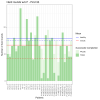Something we haven't analysed yet is whether pwME have to take breaks to be able to do hard tasks, i.e. whether there are more prominent features of high and low number of clicks that alternate and whether these dominate the lower mean behaviour more than ME/CFS vs HV does. I'll try to explain why it might be worthy of a look (even if it reveals nothing). Let's look at the plot for the first 35 rounds and only look at the hard rounds, i.e.

On the HV side the larger mean i.e. "higher effort preference" is driven by HV H, HV P and HV O, these people simply don't exist on the ME/CFS side of things. The highest performer (in terms of opting for hard games) on the ME/CFS side of things is HV D and you might not expect him to get close to those high performers in the HV group because he's one of 2 people with the least ability to complete the rounds, so it's possible that he has to take breaks. The question then is why there aren't pwME that can go hard and repetively go hard, i.e. why ME/CFS C, K & F choose far less often to go for hard then HV H, HV P and HV O, what about the other ME/CFS patients with a 100% success rate on hard trials? If that is due to a necessity of having to take breaks in-between rounds or is it a different strategy (I don't think all of these people are trying to optimize their pay-out) and if you look at the comparison of first half vs second half you will see that this difference only starts increasing in the second half so it could be fatigue driven.
I think it also makes sense to look in the literature of EEfRT studies to see how common people such as HV H, HV P and HV O usually are amongst healthy people. I'd guess they are very common (especially because in some trials people are told different instructions to ensure people don't follow strategies that end-up minimising play time on hard rounds), because I think many people will go hard if they can and if they haven't really understood what the better choice is in terms of end-rewards, but you never know, perhaps these are outliers (but I don't think so).

On the HV side the larger mean i.e. "higher effort preference" is driven by HV H, HV P and HV O, these people simply don't exist on the ME/CFS side of things. The highest performer (in terms of opting for hard games) on the ME/CFS side of things is HV D and you might not expect him to get close to those high performers in the HV group because he's one of 2 people with the least ability to complete the rounds, so it's possible that he has to take breaks. The question then is why there aren't pwME that can go hard and repetively go hard, i.e. why ME/CFS C, K & F choose far less often to go for hard then HV H, HV P and HV O, what about the other ME/CFS patients with a 100% success rate on hard trials? If that is due to a necessity of having to take breaks in-between rounds or is it a different strategy (I don't think all of these people are trying to optimize their pay-out) and if you look at the comparison of first half vs second half you will see that this difference only starts increasing in the second half so it could be fatigue driven.
I think it also makes sense to look in the literature of EEfRT studies to see how common people such as HV H, HV P and HV O usually are amongst healthy people. I'd guess they are very common (especially because in some trials people are told different instructions to ensure people don't follow strategies that end-up minimising play time on hard rounds), because I think many people will go hard if they can and if they haven't really understood what the better choice is in terms of end-rewards, but you never know, perhaps these are outliers (but I don't think so).
Last edited:


